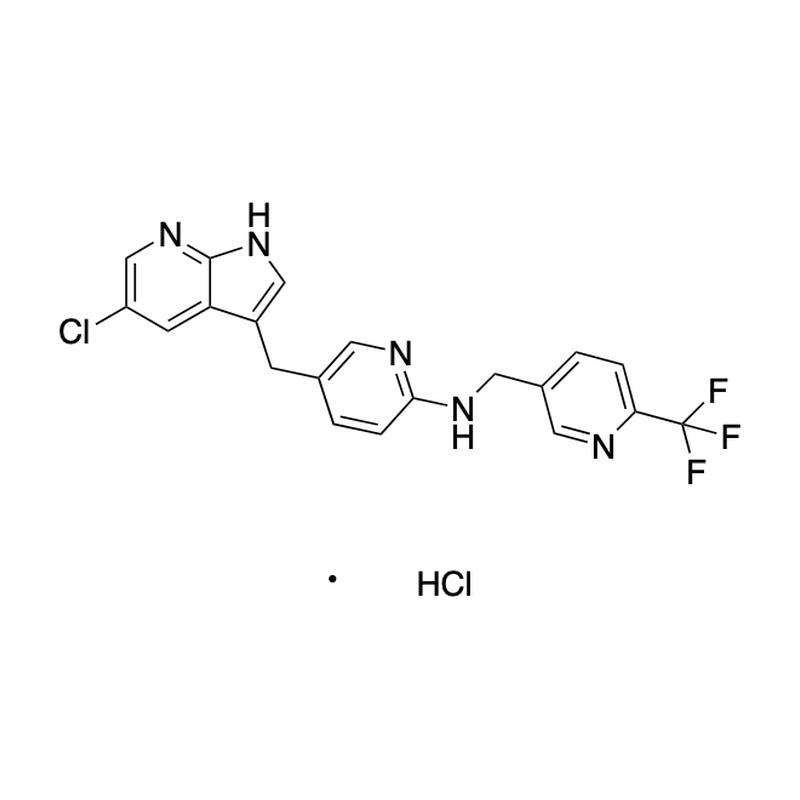产品
编 号:F251101
分子式:C20H16Cl2F3N5
分子量:454.28
分子式:C20H16Cl2F3N5
分子量:454.28
产品类型
规格
价格
是否有货
10mM*1mL in DMSO
询价
询价
1mg
询价
询价
5mg
询价
询价
10mg
询价
询价
50mg
询价
询价
结构图

CAS No: 2040295-03-0
产品详情
生物活性:
Pexidartinib hydrochloride (PLX-3397 hydrochloride) is a potent, orally active, selective, and ATP-competitive colony stimulating factor 1 receptor (CSF1R or M-CSFR) and c-Kit inhibitor, with IC50s of 20 and 10 nM, respectively. Pexidartinib hydrochloride exhibits 10- to 100-fold selectivity for c-Kit and CSF1R over other related kinases. Pexidartinib hydrochloride induces cell apoptosis and has anti-cancer activity.
体内研究:
Pexidartinib can be used to deplete the microglia cells in mice.Pexidartinib (290 ppm in AIN-76A standard chow, 21 days) depletes the microglia cells in brain by 70% in adult male C57BL/6?J mice (20–25?g).Pexidartinib (600 ppm in chow, 10 days and 30 days ) depletes the microglia cells more than 90% in brain of C57BL/6J mice.Pexidartinib hydrochloride (0.25, 1 mg/kg, i.p., twice daily for 8 days) inhibits the proliferation of microglia and BrdU-positive cells in neonatal mice.Pexidartinib hydrochloride (1 mg/kg, twice daily for 8 day) shows no obvious effect on the cleaved caspase-3-positive cells in mice.Pexidartinib hydrochloride (50 mg/kg; p.o.; every second day for 3 weeks) reduces tissue macrophage levels without affecting glucose homeostasis in mice.Animal Model:Neonatal mice
Dosage:0.25, 1 mg/kg
Administration:I.P. twice daily for 8 days
Result:Decreased the number of microglia and BrdU-positive proliferative cells, but did not change the cleaved caspase-3-positive cells.
Animal Model:10-week old litter mate C57BL/6 mice (chow and high-fat diet fed mice)
Dosage:50?mg/kg
Administration:P.o.; every second day for 3 weeks
Result:Substantially reduced macrophage numbers in adipose tissue of both chow and high-fat diet fed mice without affecting total myeloid cell levels.
体外研究:
Pexidartinib hydrochloride (PLX-3397 hydrochloride) is a potent, selective and ATP-competitive CSF1R (cFMS) and c-Kit inhibitor, shows 10- to 100-fold selectivity for c-Kit and CSF1R over other related kinases, such as FLT3, KDR (VEGFR2), LCK, FLT1 (VEGFR1) and NTRK3 (TRKC), with IC50s of 160, 350, 860, 880, and 890 nM, respectively.
Pexidartinib hydrochloride (PLX-3397 hydrochloride) is a potent, orally active, selective, and ATP-competitive colony stimulating factor 1 receptor (CSF1R or M-CSFR) and c-Kit inhibitor, with IC50s of 20 and 10 nM, respectively. Pexidartinib hydrochloride exhibits 10- to 100-fold selectivity for c-Kit and CSF1R over other related kinases. Pexidartinib hydrochloride induces cell apoptosis and has anti-cancer activity.
体内研究:
Pexidartinib can be used to deplete the microglia cells in mice.Pexidartinib (290 ppm in AIN-76A standard chow, 21 days) depletes the microglia cells in brain by 70% in adult male C57BL/6?J mice (20–25?g).Pexidartinib (600 ppm in chow, 10 days and 30 days ) depletes the microglia cells more than 90% in brain of C57BL/6J mice.Pexidartinib hydrochloride (0.25, 1 mg/kg, i.p., twice daily for 8 days) inhibits the proliferation of microglia and BrdU-positive cells in neonatal mice.Pexidartinib hydrochloride (1 mg/kg, twice daily for 8 day) shows no obvious effect on the cleaved caspase-3-positive cells in mice.Pexidartinib hydrochloride (50 mg/kg; p.o.; every second day for 3 weeks) reduces tissue macrophage levels without affecting glucose homeostasis in mice.Animal Model:Neonatal mice
Dosage:0.25, 1 mg/kg
Administration:I.P. twice daily for 8 days
Result:Decreased the number of microglia and BrdU-positive proliferative cells, but did not change the cleaved caspase-3-positive cells.
Animal Model:10-week old litter mate C57BL/6 mice (chow and high-fat diet fed mice)
Dosage:50?mg/kg
Administration:P.o.; every second day for 3 weeks
Result:Substantially reduced macrophage numbers in adipose tissue of both chow and high-fat diet fed mice without affecting total myeloid cell levels.
体外研究:
Pexidartinib hydrochloride (PLX-3397 hydrochloride) is a potent, selective and ATP-competitive CSF1R (cFMS) and c-Kit inhibitor, shows 10- to 100-fold selectivity for c-Kit and CSF1R over other related kinases, such as FLT3, KDR (VEGFR2), LCK, FLT1 (VEGFR1) and NTRK3 (TRKC), with IC50s of 160, 350, 860, 880, and 890 nM, respectively.
产品资料

